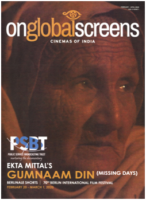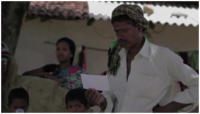Last Updated on October 16, 2021 by themigrationnews
Gumnam din (Missing Days) is a short movie of 27 minutes directed, written and researched by Ekta Mittal. The movie was shot in Hindi language and released in the year 2019. The film was funded by the Public Service Broadcasting Trust (PSBT) and edited by Abhro Banerjee. The soulful music was given by Mrithunjay Sharma and Veecheet Dhakal. Gumnaam Din is a part of a longer film and multimedia project called Behind the Tinsheets which looks at the inner worlds of migrant workers who are involved in building cities. This movie made a big mark at the Berlin Film Festival that took place from February 20 to March 1, 2020. The movie celebrates artistic freedom which delves into the pain of separation that is faced by many migrant workers who see no other choice but to work far away from their homes.
The movie Gumnam Din was inspired by Shiv Kumar Batalvi’s birha[1] poetry which explores migrant labourers’ non-migrant family members’ yearnings and pain of waiting for their loved ones to return. When a migrant leaves what happens to him/her? Do they want to return? Will they be found ever? What are their mental conditions? How does the non-migrant family cope with the separation? These are questions which are difficult to answer but the expressions of the people in the movie with their pain come to the fore, leaving the audience in awe. This movie is a journey of silence, acceptance of alienation and separation from the world at large along with several symbolic meanings.
The movie begins by showing several intertwined railway lines and a man doing his chores on the platform alone. There are visuals of electric wires which are typically seen on Indian roads also symbolically reflecting the complexity of human relationships. Like the electric wires, the human connection too is difficult to be separated. The first few seconds of the movie showcase pictures of two different men (see pictures 1 and 2). It is clear that these are the men who migrated and went missing.
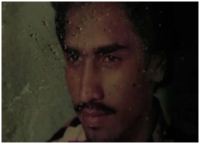
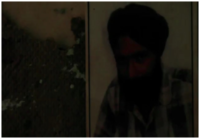
Source:https://www.youtube.com/watch?v=BHlVpPXcdIg
Symbolic expressions
The movie depicts separation being an inevitable everyday practice. In one of the scenes a rural setting is shown where an old woman was working in the kitchen making rotis[2]. She utters,“I do not know if he is there anymore or not, if we knew, then we could have found out. I wonder what happened.” The pain and grief of separation can be seen on her face while she utters only a few words in front of her family members. It is clear from these few words that this movie surrounds the grief and pain of the family members whose near and dear ones migrated and never returned.
In the next scene, there is a woman staring at herself in the mirror. Probably she is a young bride. The silence continues as there are no dialogues in the scene. The silence of the movie is broken when we see an old man and woman reading or staring at a piece of paper. At first,one may mistake it for a simple unimportant piece of paper, but the next scene clarifies it when a young man with torn clothes looks at the paper and says “I couldn’t recognize.” This is when the piece of paper turns to be a small photograph (see picture 3). With every scene emotions flow and viewers’ can well connect with it.
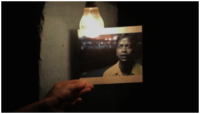
In the very next scene, there are villagers gathering around (see picture 4) the same picture and trying to identify the person in the picture and his whereabouts. The search for missing persons is done by traveling across different villages and asking respective villagers whether they have seen the missing person(s) in question.
Expressing with symbols
The scene of the young woman staring at herself in the mirror appears multiple times. This, however, does not reveal who she is getting ready for. This is left open for the audience to speculate. But the woman is waiting for someone. She does not say a word. She gets dressed, puts vermillion, and wears red bangles but still does not express what she is feeling or expecting. On several occasions in the movie, there are symbols where the camera zooms in on ants, pigeons and other birds flying away, a person walking through the fog and disappears. All these are shown, and it feels everyone is working together, flying together with family. Except for the scene of disappearance into the unknown where one can connect the separation. Along with symbols and expressions with no spoken words there is a song sung by a woman in the background of sunset around the riverbed which is the first song of the movie expressing pain.
Narratives from the city
The next scene is from the bridge construction work in the city where workers talk about being homesick. One of the workers says-
“No one is in trouble at home. I am in more trouble, nobody at home knows that. They must be thinking, who knows if he is dead or alive, rotting or surviving? Nights are sleepless. There is no motivation to work.”
The migrant worker goes on to express that he pretends to know nothing despite knowing everything.
Gumnam Din thus is not a typical literal expression but a poetic take on migrant workers and their families. The audience will see the people in the movie dreaming, leaving, disappearing, wailing, and waiting endlessly. Ekta brought the viewers closer to the experience of loss through this movie. Ekta Mittal expressed her work through a lens where family members of the migrants have no choice but to wait for their separated and missing dear ones. In-between, the lives of the family members become difficult. Although the movie leaves an impact, the only concern I felt is why the migrant worker hides his identity even when he is alive. I highly recommend this movie to everyone to understand the perspective of the missing migrant worker and those who wait for them in the villages endlessly. It is a well-researched and produced film to understand the pain and grief from both sides.
[1] Birha is separation
[2]bread, especially a flat round bread cooked on a griddle

Bhowmick Piyali is a PhD scholar at the Tata Institute of Social Sciences, Guwahati Off Campus, India. She obtained MPhil degree in 2016 in Social Sciences from TISS Guwahati campus. She has done MA in Sociology in 2014 from Ambedkar University Delhi, New Delhi. Her areas of interest include- Labour Process, Manufacturing Industry, Sociology of everyday lives, Migration, Family and Kinship, Migration and Social networks.

